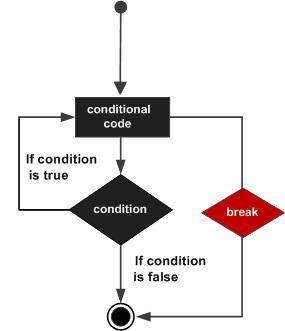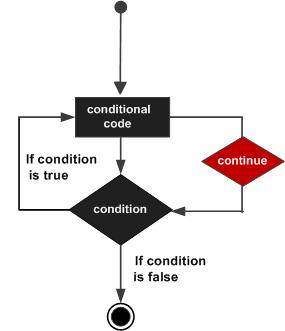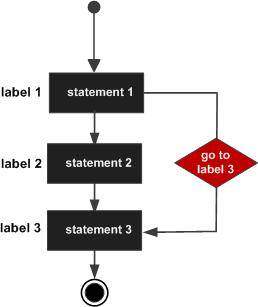Loop Control Statements

Loop control statements change execution from its normal sequence. When execution leaves a scope, all automatic objects that were created in that scope are destroyed.
C++ supports the following control statements. Click the following links to check their detail.
| Control Statement | Description |
|---|---|
| break statement | Terminates the loop or switch statement and transfers execution to the statement immediately following the loop or switch. |
| continue statement | Causes the loop to skip the remainder of its body and immediately retest its condition prior to reiterating. |
| goto statement | Transfers control to the labeled statement. Though it is not advised to use goto statement in your program. |
"Break Statement"
The break statement has the following two usages in C++:
- When the break statement is encountered inside a loop, the loop is immediately terminated and program control resumes at the next statement following the loop.
- It can be used to terminate a case in the switch statement (covered in the next chapter).
If you are using nested loops (i.e., one loop inside another loop), the break statement will stop the execution of the innermost loop and start executing the next line of code after the block.
Syntax:
The syntax of a break statement in C++ is:
break;
Flow Diagram:

Example:
#include <constream.h> int main () { // Local variable declaration: int a = 10; // do loop execution do { cout << "value of a: " << a << endl; a = a + 1; if( a > 15) { // terminate the loop break; } }while( a < 20 ); return 0; }
When the above code is compiled and executed, it produces the following result:
value of a: 10 value of a: 11 value of a: 12 value of a: 13 value of a: 14 value of a: 15
"Continue Statement"
The continue statement works somewhat like the break statement. Instead of forcing termination, however, continue forces the next iteration of the loop to take place, skipping any code in between.
For the for loop, continue causes the conditional test and increment portions of the loop to execute. For the while and do...while loops, program control passes to the conditional tests.
Syntax:
The syntax of a continue statement in C++ is:
continue;
Flow Diagram:

Example:
#include <constream.h> int main () { // Local variable declaration: int a = 10; // do loop execution do { if( a == 15) { // skip the iteration. a = a + 1; continue; } cout << "value of a: " << a << endl; a = a + 1; }while( a < 20 ); return 0; }
When the above code is compiled and executed, it produces the following result:
value of a: 10 value of a: 11 value of a: 12 value of a: 13 value of a: 14 value of a: 16 value of a: 17 value of a: 18 value of a: 19
"Goto Statement"
A goto statement provides an unconditional jump from the goto to a labeled statement in the same function.
NOTE: Use of goto statement is highly discouraged because it makes difficult to trace the control flow of a program, making the program hard to understand and hard to modify. Any program that uses a goto can be rewritten so that it doesn't need the goto.
Syntax:
The syntax of a goto statement in C++ is:
goto label; .. . label: statement;
Where label is an identifier that identifies a labeled statement. A labeled statement is any statement that is preceded by an identifier followed by a colon (:).
Flow Diagram:

Example:
#include <constream.h> int main () { // Local variable declaration: int a = 10; // do loop execution LOOP:do { if( a == 15) { // skip the iteration. a = a + 1; goto LOOP; } cout << "value of a: " << a << endl; a = a + 1; }while( a < 20 ); return 0; }
When the above code is compiled and executed, it produces the following result:
value of a: 10 value of a: 11 value of a: 12 value of a: 13 value of a: 14 value of a: 16 value of a: 17 value of a: 18 value of a: 19
One good use for the goto is to exit from a deeply nested routine. For example, consider the following code fragment:
for(...) { for(...) { while(...) { if(...) goto stop; . . . } } } stop: cout << "Error in program.\n";
Eliminating the goto would force a number of additional tests to be performed. A simple breakstatement would not work here, because it would only cause the program to exit from the innermost loop.
The Infinite Loop:
A loop becomes infinite loop if a condition never becomes false. The for loop is traditionally used for this purpose. Since none of the three expressions that form the for loop are required, you can make an endless loop by leaving the conditional expression empty.
#include <constream.h> int main () { for( ; ; ) { printf("This loop will run forever.\n"); } return 0; }
When the conditional expression is absent, it is assumed to be true. You may have an initialization and increment expression, but C++ programmers more commonly use the for(;;) construct to signify an infinite loop.
NOTE: You can terminate an infinite loop by pressing Ctrl + C keys.


0 comments:
Post a Comment